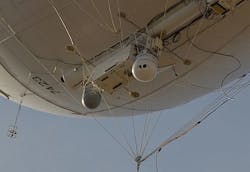Logos to provide airborne persistent-surveillance sensors in $111.8 million Navy contract
FAIRFAX, Va., 1 Oct. 2012.Persistent surveillance expert Logos Technologies Inc. in Fairfax, Va., won a $111.8 million from the U.S. Navy to build 22 Kestrel wide-area electro-optical surveillance systems to support U.S. forces in the field, Logos officials announced today.
Awarding the contract were officials at Naval Air Systems Command at Patuxent River Naval Air Station, Md. Logos won a $28 million Navy contract last month for three Kestrel surveillance and reconnaissance systems for deployment on aerostats and airships operating in Afghanistan at altitudes between 1,000 and 5,000 feet off the ground.
The Logos Kestrel day/night wide-area persistent surveillance system is an imaging payload for helium-filled aerostats that remain aloft for about a month, and can store continuous video data for all of that time.
The Kestrel persistent surveillance system uses electro-optical sensors to scan a city-sized area at once during the day and at night to provide a heightened level of security for troops at forward operating bases, such as those in Afghanistan or along the Southern U.S. border with Mexico.
“Since the first units were deployed in Afghanistan, Kestrel has saved the lives of countless warfighters by preventing IED attacks and providing our forces with greater situational awareness,” says Greg Poe, CEO of Logos Technologies.
Logos will deliver 20 Kestrel systems and spares, as well as two units for testing and upgrading. The company also will provide operational, logistical, and analytical support on Kestrel through 2013.
With its 360-degree field of view, Kestrel enables intelligence analysts to track and record several different targets in medium-resolution over many kilometers. Kestrel also can cue full-motion video sensors for high-resolution imaging. The system also can operate autonomously.
Kestrel is currently employed on both the Persistent Threat Detection System and Persistence Ground Surveillance System in Afghanistan. But it also has applications for border patrol, counter-trafficking and other homeland security missions.
For more information contact Logos Technologies online at www.logos-technologies.com, or Naval Air Systems Command at www.navair.navy.mil.
Follow Military & Aerospace Electronics and Avionics Intelligence news updates on Twitter

